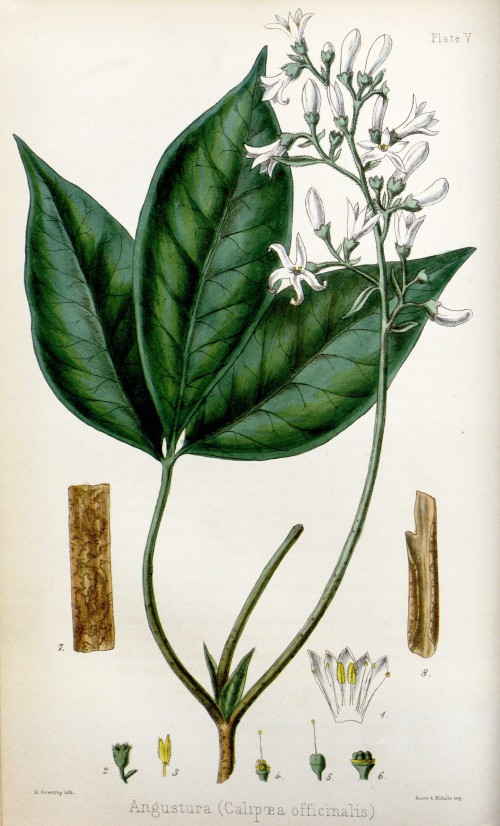Angostura trifoliata (Willd.) T. S. Elias - syn.Galipea officinalis Hancock; Cusparia trifoliata (Willd.) Engl. - Rutaceae
cuspa (span.), angostura, Angostura
Shrub or small tree of the rainforest, up to 12m high, native to Venezuela (Orinoko), naturalized in tropical Central and South America; bark smooth, grey; leaves shiny, trifoliate, terminal leaflet up to 30cm long, smelling like tobacco; panicles of white, tubular, five-lobed flowers with unpleasant smell; fruit a five-celled capsule; seeds black, round.
Preparations from Galipea officinalis have been used in folk medicine for the treatment of dysentery and fever.
[Lehrbuch der Biologischen Heilmittel, Gerhard Madaus, 1938]
Bark extracts have been used as a bittering agent in the preparation of liqueurs. Products bearing the name Angostura are not necessarily prepared from the bark extract but, for example, gentian root or other bitter drugs.
[Hagers Handbuch der Pharmazeutischen Praxis, Springer 2010; Furia TE, Bellanca N, Fenaroli's Handbook of Flavour Ingredients, 2.ed., CRC Press, Palo Alto, 1975, 277–278]
„Angostura bark (from Galipae officinalis, Rutaceae) contains two unstable bitter principles, which are isolated in the form of their crystalline hexaacetates. The structure of the bitter principle has been shown to be 3,5-Dihydroxy-5-ethoxy-2-syringoyl-1-methyl-4-O-β-d-glucopyranosyl-cyclopentane, the bitter principle 2 to be 3,5-Dihydroxy-5-ethoxy-2-vanilloyl-1-methyl-4-O-β-d-glucopyranosyl-cyclopentane.“
[Über die Bitterstoffe der Angosturarinde. Brieskorn, C. H., Beck, V., Phytochemistry, Vol.10(12), 1971, 3205-3211]
The bark of G.officinalis contains tetrahydroquinoline alkaloids like angustureine (1,2,3,4-tetrahydro-2(n-pentyl)-1-methylquinoline), cuspareine, galipeine (2-[(3′-hydroxy-4′-methoxy-phenylethyl)]-2,3,4-tetrahydro-1-methylquinoline) and N-methyl-2-propyl-tetrahydroquinoline.
[Two tetrahydroquinoline alkaloids from Galipea officinalis. Jacquemond-Collet, I., Hannedouche, S., Fabre, N., Fourasté, I., Moulis, C., Phytochemistry, Vol.51(8), 1999, 1167-1169]
Of the tetrahydroquinolines from G.officinalis, galipinine yielded the best antimalarial effect (IC50: 0.09 - 0.9 μg/ml) on chloroquine-resistant strains of P. falciparum.
[Antiplasmodial and Cytotoxic Activity of Galipinine and other Tetrahydroquinolines from Galipea officinalis. Jacquemond-Collet, I., Benoit-Vical, F., Valentin, M., Stanislas, A., Mallié, E., Fourasté, M., Planta medica, Vol.68(01), 2002, 68-69]

Angostura trifoliata (Willd.) T.S.Elias as Galipea officinalis J.Hancock
Hamilton, E., Flora homoeopathica, vol.1 t.5 (1852)
http://plantgenera.org/species.php?id_species=64156
